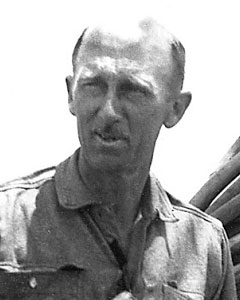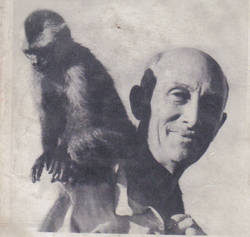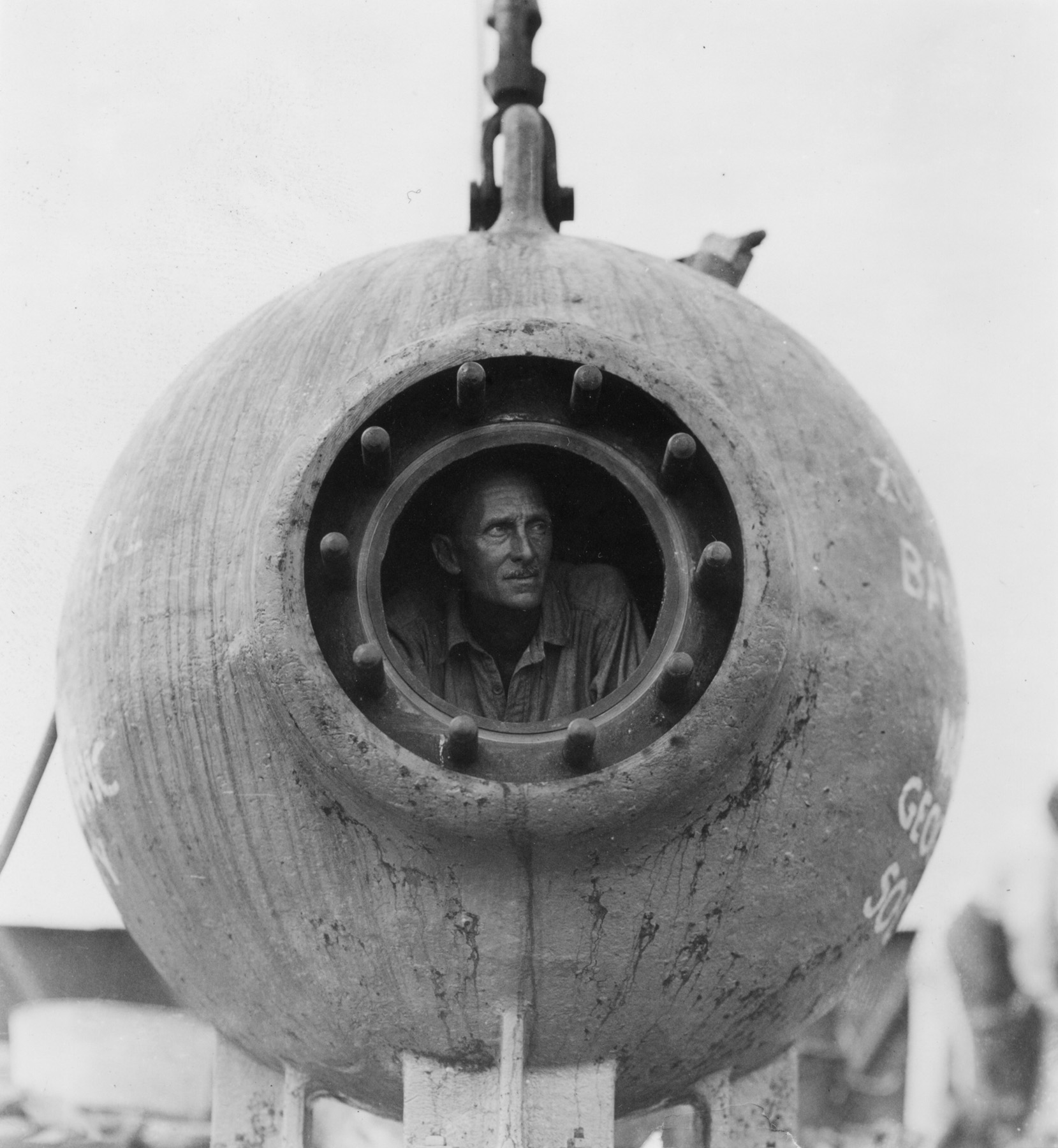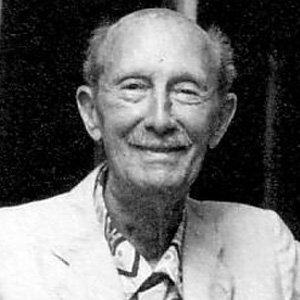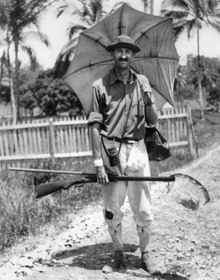William Beebe
Charles William Beebe [' bi: bi ] ( born July 29, 1877 in New York City; † 4 June 1962, Arima, Trinidad ) was an American ornithologist, ichthyologist, deep sea explorer and environmentalist. For his work he was awarded, among others, the John Burroughs Medal.
Life
Beebe was born in 1877 the son of a paper merchant. Through his interest in biology and numerous visits to the Natural History Museum in New York, he won the friendship of the local director, Henry Fairfield Osborn. After a scientific education at Columbia University ( no academic degree ), he worked from 1899 to the ornithological department of the Zoological Gardens of New York. There he soon made a name for himself as a talented bird orderlies. In 1902 he married the farmer's daughter Mary Blair Rice from Virginia. These accompanied him on his ornithological expeditions. In 1913 she got a divorce from Beebe again to marry the architect Robert L. Niles just one day later. In public, however, William was branded as the cause of the marriage crisis.
That same year, Beebe took over the management of the newly established Department of Tropical Research. For this he founded in 1916 the first tropical research station in British Guiana. Later, another followed in Bermuda. On his first expedition to the Galapagos Islands in 1923 he climbed an active volcano and suffered poisoning from the effluent gases. Around this time he also began with the helmet diving to explore the wildlife of the oceans in their natural habitat can.
In 1927 he married the younger to 25 years Elswyth writer Thane Ricker from Vermont. He then developed with Otis Barton bathysphere, a diving bell, with which they reached a then-record depth of 923 m on 15 August 1934. Cooperation between Beebe and Barton did not last; the two soon went their own way after. The depth record was surpassed in 1948 ( without the participation Beebe ) of Barton in his newly constructed bathysphere Benthoscope with 1,370 m. (1960 Jacques Piccard reached the maximum sea depth, almost 11,000 m, also in a steel ball, but with its own buoyancy body, the dive boat "Trieste ". )
In 1944, Beebe first met Rachel Carson who wrote the afterword for one of his books. He encouraged them to do well even research and diving trips and to publish their results. Since the research station had been converted in Bermuda during the Second World War an airbase, founded Beebe using his books fees a new base in Trinidad. This station called Simla is still a popular spot for ornithologists and bird lovers.
1952 Beebe retired at the age of 75 years. Of course, he worked on "his " research station Simla further supported by his longtime assistant zoological Jocelyn Crane (1909-1998), died here on June 4, 1962 and is buried in Trinidad.
Work
Beebe went on many expeditions to observe the wildlife. Among other things he has done the following trips:
For his diving trips he had first provided an old petrol can with a glass window. The air supply for this diver helmet was made via a hose connection with a hand pump, which is on land ( or boat ) was located. With this construction, it reached 15 m water depth, where he observed many animals and documented.
Soon grew in him the desire to penetrate to greater depths. However, He did not want to squeeze into already known at that time diving bells, with which depths of 100 m and more readily could be achieved, in which case the diver but was fairly immobile. So he went in search of a new diving apparatus. Together with his partner, the engineer Otis Barton, he began in 1929 the construction of the first bathysphere, as he named his bathysphere like a deep sea fish. In June 1930 Beebe and Barton took the first attempts to dive off the coast of Bermuda; initially to 76 m and then deeper and deeper until they reached 435 m. The diving bell hung by a steel cable on the winch on the carrier ship ready; In addition, a power cord is ( for the illumination ), and a telephone line is supplied ( for communication ). The oxygen supply was done with bottles directly into the bathysphere, the carbon dioxide was absorbed by caustic potash.
After this first successful attempt further improvements to the bathysphere were performed. In another experiment ( the 32 dive) on 15 August 1934, the record of 923 m was achieved. These dives numerous sketches and photos of hitherto never observed deep-sea animals originated. Many of them, such as Bathysphaera intacta have since been never seen again or even caught and are therefore considered as products Beebescher imagination. In addition, he also studied the propagation of light in different depths of the sea.
About all his expeditions and things Beebe has published numerous books. The fees he achieved it, he used in part to finance the tropical research stations.
Some contemporaries accused Beebe against excessive populism, which could not keep up the results of his research. In particular, the scientific value of his dives to great depths were questioned ( by writing researchers and envious ) frequently. With more law other designated him as a " first ecologists of North America ".
After a dive William Beebe said: " These fish have not only a half-dozen shed, but they shone as in a shining armor, shrimp and jellyfish drove past us like flakes unsuspected snow storms. "
Bibliography (excerpt)
- William Beebe and Mary Blair Rice: Two Bird Lovers in Mexico, 1905
- William Beebe and Mary Blair Rice: Our Search For a Wilderness, 1908 ( Venezuela and Trinidad )
- However, was A Monograph of the Pheasants, emerged as a four -volume work, 1912-1913, published in 1918, only the first volume: William Beebe and Mary Blair Rice.
- William Beebe: The Arcturus adventure: an account of the New York Zoological Society 's first oceanographic expedition. . Putnam, New York 1926 German edition: The Arcturus adventure. The first deep-sea expedition of the Zoological Society Neuyorker, FA Brockhaus, Leipzig 1928
- William Beebe: Galapagos: World's End, 1926
- William Beebe: Half Mile Down, 1934 ( German: 923 meters below sea level, 1935)
- William Beebe: High Jungle, 1953 ( insect research in Venezuela)
- William Beebe: Adventuring with Beebe 1955 ( the most interesting stories from his oeuvre ).

